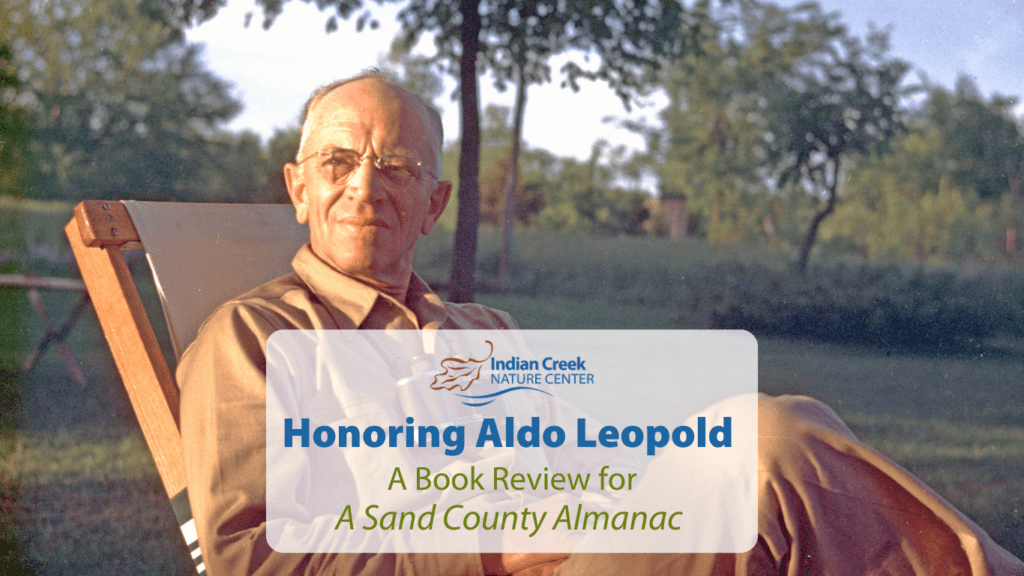Celebrating Aldo Leopold’s Legacy

Before Buddy Huffaker, Executive Director of the Aldo Leopold Foundation, comes to speak at Indian Creek Nature Center on April 25, we want to take a look back at Aldo Leopold’s legacy.
Aldo Leopold redefined conservation in his 1948 book A Sand County Almanac with the concept of The Land Ethic — which expanded the world of ethics to include the relationship between humanity and land. This idea was built upon decades of Leopold’s own life experiences, scientific research and keen observations of the natural world.
A Sand County Almanac, published a week before Leopold’s death, is seen by many as a must-read for modern conservationists. In celebration of the lasting inspiration of his work, we are sharing a book review of Leopold’s magnum opus.
Book Review of A Sand County Almanac
“Conservation is a state of harmony between men and land.” – Aldo Leopold
Leopold gives a masterclass on conservation with writing that is at times poetic and other times piercing straight into the heart of the misguided conservation movement of his time.
The book is broken into three parts, each with its own method for laying out the case that wildlife and the habitats they depend on “should be protected from extinction as a matter of ethics.” Together, these three parts explain the what, why and how of land ethics.
Part I: The What of Land Ethics
“How could a weed be a book?” – Aldo Leopold
Part I highlights what we need land ethics for by showing the complexity and beauty of nature through a year’s worth of observations of the wildlife, plants and land at an old farmstead.
Month by month, Leopold guides us into the wilderness surrounding his farmhouse with well-earned observations of the natural world that can only be seen by those willing to take the time to slow down and notice the beauty hidden in every marsh, tree, or riverbend.
With a one-man discussion on goose conversation patterns, a history lesson told by the rings of a downed tree, a detailed account of a bird’s morning dance, and a love letter to pine trees, Leopold passes his appreciation for non-human activity along to the reader.
The land where Leopold made his eye-opening and wonder-inducing observations was no longer farmed due to its sandy soil. Since the marshes and woodlands were allowed to return, Leopold was able to make the discoveries within A Sand County Almanac that reveal to us how even land deemed economically unprofitable holds immeasurable value that humans have a moral obligation to conserve.
Part 2: The Why of Land Ethics
“Man always kills the thing he loves, and so we pioneers have killed our wilderness.” – Aldo Leopold
Part II lays out why there’s a need for land ethics by putting the problem of habitat destruction on full display with personal accounts of ecosystems across the continent impacted by human activity.
Leopold shares stories of his travels in different wild areas of the Americas, from valleys in Illinois to mountains in Arizona, that have been lost to the march of progress. Patterns emerge of hunters, conservationists and nature enthusiasts seeking greater access to wild spaces and then “the roads come through.”
The same roads that give wilderness-loving humans access to wild spaces slowly divide habitats, spread destructive invasive species, and destroy the delicate balance required to preserve the wilderness. Leopold notices that despite the loving and good intentions of the conservationists of his time, many of their policy, game management and land use choices were based solely on economics without any consideration of ethics.
Leopold also took pages to share the slow pace at which nature heals itself, which then stands in stark contrast to numerous accounts of wild habitats that have been lost during his lifetime.
While pining for the wild adventures he cherished in his youth that others will never know, he makes clear a land ethic is needed before “there is no wilderness left to cherish.”
Part 3: The How of Land Ethics
“Land ethic changes the role of Homo sapiens from conqueror of the land-community to member and citizen of it.” – Aldo Leopold
Part III provides how land ethics can redirect conservation efforts to “understand and preserve the capacity of the land to renew itself back to health.”
Arguments for a land ethic in Part III include a critique of the conservationists of his time who saw land and wildlife in economic terms. Leopold claimed that requiring life to have economic value for humans is a poor, incomplete and unethical method for deciding which lifeforms are worthy of ethical care.
Leopold argued that after ethics was developed between individuals, and between individuals and society, the next logical extension of ethics was to the relationship between land and humanity. He wanted to “simply enlarge the boundaries of the community to include soils, waters, plants, and animals, or collectively; the land.”
Land ethics lays the obligation to make ethical choices for the good of the land-community at the feet of all landowners, public or private, city dweller or farmer, regardless of profitability.
Leopold lays out how wilderness has non-economic value due to its role in scientific research, its capacity for sport and recreation, its standing as a keystone of human culture, and the ecological value of allowing each part of an ecosystem to remain free from extinction.
By the time you turn the final page of A Sand County Almanac you’ll understand the what, why and how of land ethics — and why it came to define conservation over the last 77 years.
Through his research, writings and life, Aldo Leopold taught us that “a thing is right when it tends to preserve the integrity, stability and beauty of the [biological] community.”
He also reminds us (with a critique so sharp it still pierces us today) that there is still much work to be done. “Perhaps the most serious obstacle impeding the evolution of a land ethic is the fact that our educational and economic system is headed away from, rather than toward, an intense consciousness of land.”

